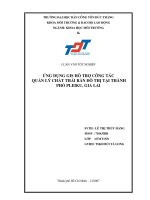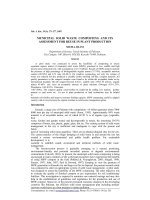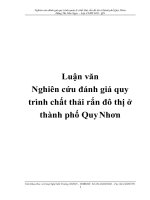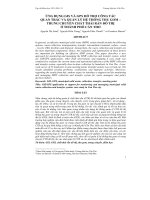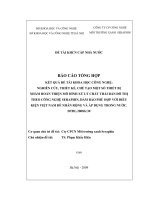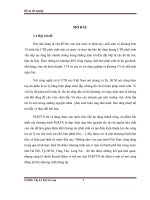Đề tài " Chất thải rắn đô thị và ủ phân "
Bạn đang xem bản rút gọn của tài liệu. Xem và tải ngay bản đầy đủ của tài liệu tại đây (180.89 KB, 7 trang )
Pak. J. Bot., 39(1): 271-277, 2007.
MUNICIPAL SOLID WASTE COMPOSTING AND ITS
ASSESSMENT FOR REUSE IN PLANT PRODUCTION
SEEMA JILANI
Department of Science, Textile Institute of Pakistan,
City Campus: 10F, Block-6, PECHS, Karachi-75400, Pakistan.
Abstract
A pilot study was conducted to assess the feasibility of composting of source separated
organic matter of municipal solid waste (MSW) generated in low, middle and high income areas of
Karachi city with a population over 14 million. Results of MSW analysis indicate the presence of
high percentage of biodegradable organic matter (71-74%), acceptable moisture content (40-50%)
and C/N ratio (38-40:1). On windrow composting, not only the volume of waste was reduced but
also produced a crumbly earthy smelling soil-like, compost material. All quality parameters in the
compost samples were found to be within the acceptable limits set by international standard. The pH
ranged between 6.8-8.1, soluble salts 3.90-5.10 mS/cm, organic matter 45-60% and have an
acceptable amount of plant nutrients (Nitrogen 0.91-1.35%, Phosphorus 0.42-0.85%, Potassium
1.00-1.80%). The compost quality could further be improved by adding cow manure, poultry manure
or yard waste etc. Its use in plant production or land reclamation may be helpful to
maintain soil fertility and improve moisture holding capacity. MSW composting could be adapted
country wide to recycle/reuse the organic residues as solid waste management option.
Introduction
Karachi, a mega city of Pakistan with a population >14 billion generates about 7000-
8000 tons per day of municipal solid waste (Anon., 1993). Approximately 89% waste
material is of recyclable nature, out of which 65-70 % is of organic type (vegetable,
fruit
waste, kitchen and garden waste) and decomposable in nature, the remaining 30-35%
comprises of bones, tins, plastic, paper, glass, dirt etc. The existing system of solid waste
management in the city is inefficient and inadequate to cope with the present and
future
need of increasing solid waste quantities. There are no planned disposal sites for the city.
The current practice of the illegal dumping of solid waste in and around the city has
created a serious environmental and public health problem. For sustainable
development, it is
essential to establish sound, economical and technical methods of solid waste
management.
The bioconversion process is gradually emerging as a natural, promising,
environment-friendly and potential microbial process to degrade environmental
contaminants (Colwell, 1994). At present, the municipal solid waste composting is being
encouraged in many countries of the world and researchers have experienced the benefits
of using MSW compost in the field (Pokhrel & Viraraghavan, 2005; Abigail, 1998;
Francis, 1997; John, 1997; Paul & Howard, 1997). Keeping in view the quantum of
MSW generation in Karachi city and huge cost for its disposal, the present research study
was conducted to select an appropriate system of solid waste management. A pilot study
was designed to assess the feasibility of the MSW composting. The other objective was
to evaluate the quality of finished compost as per requirement for soil conditioning/
fertilizer. This investigation is expected to minimize raw material wastage and may also
help in the establishment of guidelines and regulations for the production and use of
MSW compost. Moreover, in the present restrained economic situation in the developing
countries like Pakistan, the efficient solid waste management plan including product
rec o very w ou l d s e rve as a b e st m easure to r educe p o ll u ti o n.
Correspondence to: e-mail: see m ajilani @ hotmail.com, Phone: 92-21-4750611-14 Ext: 355
16
SEEMA JILANI
Materials and Methods
The research study was conducted at NED University campus in the month of
December 2003 at ambient temperature ranging from 18 to 26ºC. Domestic solid waste
samples were collected from 6 different localities of Karachi city, representing high,
middle and low socio-economic areas. The organic material mainly vegetable, fruit and
kitchen waste etc., were separated manually and subjected to windrow composting
process. Scientific balance with capacity ranging up to 100 kilograms was used to
determine the actual percentage of organic waste generated at various income groups.
The total weight of introduced organic material for composting and the finished compost
were calculated by weighing. The required operating conditions of moisture, temperature,
air etc., were maintained throughout the composting process (Haug, 1980). Aeration
typically in the pile was provided by manually turning of waste. The turning loosens,
mixes and adds moisture to homogenized and aerated the material in the pile as well as
reposition of the piles.
A pile of mixed solid organic waste of 3 feet high was placed on concrete
surface/paved ground and was watered regularly to maintain moisture level between 45-
50% and turned manually every 3-5 days for the first six weeks of composting cycle.
From the seventh week, the moisture was allowed to drop when optimum biosolids
decomposition was achieved. This process completed in about 8-9 weeks. After this
period the compost was allowed to cure for additional three weeks without turning.
During the curing period residual decomposable organic material were further reduced by
fungi and actinomycetes. The finished compost was then screened out and weighed.
Analysis
The physical and chemical characteristics of various compost samples were carried
out in the laboratory using standard procedures. Similarly, samples of cow dung as
organic fertilizer and commercial fertilizer were also analyzed to compare its quality with
compost. Accuracy in the results were obtained by analyzing each sample 8-10 times for
each parameter. Representative samples were first ground to homogenous powder in a
miller apparatus and then analyzed. Soluble salts and pH were measured in a suspension
of 10 gm in 100 ml of distilled water using Hach Portable Conductivity Meter and Orion
pH-meter. Moisture content was determined by drying well mixed samples in an oven at
105
o
C for 24 hours and expressed as a percentage of total weight. The volatile solids
content of organic matter was determined on the dried sample taken for the moisture
content test by measuring loss on ignition at 550
o
C for 3 hours using a muffle furnace.
The weight loss represented organic content that were expressed as a percentage of dry
solids (Anon., 1990). Phosphorus was analyzed by spectrophotometer and the
concentration of potassium in the samples were measured using flame photometer. The
details of the analysis are presented elsewhere (Anon., 1990; Brawn, 1990). Total
Kjeldahl Nitrogen was estimated by ASTM method of analysis (Anon., 1990). Carbon
percentage in the samples were calculated according to the New Zealand formulae
(Anon., 1951), in which percent organic matter present in the sample was divided by
1.724.
Parameters Average values
pH 6.4
Moisture (% dry basis) 36
Organic matter (% wet basis) 57
Nitrogen (% dry basis) 0.81
Carbon (% dry basis) 33
MUNICIPAL SOLID WASTE COMPOSTING AND PLANT PRODUCTION
17
Table 1. Composition of municipal solid waste in high, middle and low
socioeconomic localities.
Components High (% by weight) Middle Low
Food wastes 74.10 73.45 71.15
Paper & Cardboard 9.30 6.92 4.33
Plastic & Polythene 6.00 9.50 13.72
Textile 1.50 2.73 5.40
Rubber & Leather 1.10 1.30 -
Metals & Tin 3.60 1.90 -
Glass 4.40 3.10 1.60
Miscellaneous - 1.10 3.80
Table 2. Average chemical composition of municipal solid waste.
*
Standard values suitable
for composting
5.5-8.0
< 50
> 20
> 0.6
No specs
C/N ratio (total d ry we i ght) 40 : 1 2 5- 50 : 1
*
Standard (Zucconin & deBertoldi, 1987),
*
Data was produced during author’s association with NED University of Engineering
&
Technology,
Karachi.
Results and Discussion
Presence of high percentage of biodegradable organics (73%) and comparison of the
average values of C/N ratio (40:1), pH (6.4), organic matter (57%), and moisture content
(36%) of the MSW samples against those of standards value (Anon., 1987), shown in
Table 1 and 2 indicate that the organic fraction of refuse is suitable for composting
process. The refuse generated in India, Mexico and Great Britain is compostable in nature
(Flintoff, 1976), as also established by PCSIR study (Khatib et al., 1990), and confirmed
during the present research study. However, to obtain good quality compost, the C/N
ratio of the waste can be adjusted to an optimum level by adding cow manure, poultry
manure, garden waste etc. As several researchers have drawn attention that successful
preparation of MSW composts depended upon the nature of the organic materials, the
proportion of nitrogenous compound to carbohydrates, the temperature of decomposition
and the microbial population involved in the process (Babyranidevi & Bhoyar, 2003; Xi
et al., 2003).
The composting procedure used during the pilot study was aerobic windrow type.
The advantages of windrow process over other composting process lies into its
simplicity, low level technology and involvement of unskilled labor that is usually
employed in running the process. Therefore windrow process can be easily managed in
rural and urban areas of developing countries including Pakistan. Moreover, it has been
established that the capital, operational and maintenance costs for windrow composting
are relatively low (Technobanoglous, 1993; Haug, 1980; Gotass, 1956). This method is
best suitable for the tropical climate like the climate of Karachi city, where the
temperature remains moderate with mean minimum and maximum temperature ranging
between 20 and 32
o
C and humidity between 49 and 75%. Summer season last long for
eight-month extending from end of March to October and the winter season is not very
18
SEEMA JILANI
cold. Process data such as temperature, moisture content, and mass reduction etc., were
monitored during the composting and curing period. During the process, the initial mix of
organic waste was watered regularly to maintain optimum moisture content of about 45-
50%, and aeration rate was increased by frequent turning of the waste every 4-5 days to
homogenize the material and to maintain adequate temperature to support the accelerated
microbial growth typically required for composting environment. It was observed during
the process that the mixture heated up rapidly, reaching a temperature of 48
o
C after one
day of composting. By maintaining the temperature of 48-50
o
C for initial 3 days of the
process, the frequency of turning and mixing of the waste was increased to obtain
temperature between 35-40
o
C, (an optimum level for microbial degradation). During
composting, the mass reduction was estimated by weighing the waste under process from
time to time. It was noted that the weight loss gradually became more pronounced during
first week of the test, as microbial activity increased to maximum. It was observed that, in
winter season, the composting process was completed in about 8-10 weeks, whereas in
summer season it took only about 4-6 weeks. The weight reduction in winter season was
found to be more than 60%, where as in summer it was above 70%. Similar findings were
observed by (Andrea et al., 1998).
In order to assess the compost maturity, the compost sample was placed in a sealed
bag for a week. After a week, the seal was broken and the odor was smelled, which was
found to have earthy smell, indicating the quality of stable and mature compost. The
screened compost samples were drawn and analyzed in the laboratory for the parameters
such as pH, soluble salts, organic matter, essential plant nutrients (nitrogen, phosphorus,
potassium) and C/N ratio. The results of the analysis are shown in Table 3 and 4 and also
compared against those of International Standards set for good quality compost. The pH
value (6.8-8.1) and soluble salts (3.90–5.10 mS/cm) were found to be within the
acceptable limits. A high organic matter content ranging from 45–60% was found,
whereas the C/N ratio (26-27.0), lies within the acceptable limits but inclined towards the
higher values meaning the compost may need supplements to increase its nitrogen value.
The low nitrogen value could further be improved by adding phosphoric acid in the waste
(Dinel et al., 2004). It prevents the excessive volatilization of ammonia during the meso
and thermophilic phases of composting. These findings are in accordance to the previous
study where it is reported that usually the nitrogen concentration in the compost sample is
less available than the nitrogen in the feedstock from which the compost is made due to
volatilization of ammonia (Dinel et al., 2004; Paul & Jessie, 1997). Therefore, it is
important to balance the feedstock or to add phosphoric to ensure the loss of nitrogen
during composting. With regard to agronomic parameters, the quantities of essential plant
nutrients, especially nitrogen content (0.91–1.35%), phosphorus (0.42-0.85%) and
potassium (1.00-1.80%), were found within the acceptable limits as required for soil
conditioning (Abigail, 1998).
According to standard, excellent quality compost generally contain high
concentration of nitrogen but no specific value set for phosphorus or potassium The
MSW compost prepared during the present study was found to be as good as cowdung
and chemical fertilizer (Table 4). Therefore, its use in Karachi sandy soil, may add humus
and improve the aeration, aggregation and water holding capacity. It is reported that good
quality compost can increase the crop yield as much as 10% (Poincelot, 1975). Further,
its use helps to prevent erosion, supplies slow release of nutrients and can control
numerous soil born diseases (Abigail, 1998; John, 1997). The present study would
suggest that MSW composting and the quality of compost could further be improved by
adding inoculating agent in the waste and the volatilization of nitrogen in the form of
ammonia could be reduced by phosphoric acid treatment during composting.
MUNICIPAL SOLID WASTE COMPOSTING AND PLANT PRODUCTION
19
Table 3. Comparative average values of pH, soluble salts, organic matter content
o f MSW co mpo st, co w dung an d chemical fertilizer sa mples.
Sample type pH
Soluble salts
(mS/cm)
Organic matter
(%dry basis)
MSW compost 7.50 ± 0.32 4.19 ± 0.22 58 ± 1.4
(High income) (6.8-7.8) (3.90-4.50)
(56-60)
MSW compost 7.42 ± 0.27 4.72 ± 0.15 56 ± 1.32
(Middle income) (7.1-8.0) (4.35-4.82)
(54-58)
MSW compost 7.78 ± 0.03 4.83 ± 0.12 48 ± 1.79
(Low income) (7.0-8.1) (4.72-5.10)
(45-50)
Cow dung 7.91 ± 0.18 4.81 ± 0.04 50 ± 1.5
(Organic fertilizer) (7.6-8.2) (4.75-4.88)
(48-52)
Chemical fertilizer 6.95 ± 0.11 5.67 ± 0.13 38 ± 0.71
(6.8-7.1) (5.40-5.80)
(37-39)
Proposed Italian
Standard 5.5-8.0 <5 >20
*Data was produced during author’s association with NED University of Engineering & Technology, Karachi.
Table 4. Comparative average nutritional values and C/N ratio of composts,
cow dung and chemical fertilizer samples.
Sample type
Org. Carbon
(%)
Nitrogen
(%)
dry
basis
Phosphorus
(%) dry basis
Potassium
(%)
dry
basis
C/N
Ratio
MSW Compost 31.90 ± 1.40 1.19 ± 0.14 0.57 ± 0.10 1.61 ± 0.22 27.03
(High income) (0.94-1.35) (0.42-0.70) (1.30-1.80)
MSW Compost 29.58 ± 1.32 1.11 ± 0.08 0.58 ± 0.09 1.58 ± 0.22 26.64
(Middle income) (0.95-1.18) (0.45-0.72) (1.20-1.80)
MSW Compost 27.80 ± 1.79 1.09 ± 0.11 0.64 ± 0.09 1.32 ± 0.19 25 50
(Low income) (0.91-1.20) (0.55-0.85) (1.00-1.50)
Cow dung 29.00 ± 1.50 1.19 ± 0.16 0.55 ± 0.07 3.81 ± 0.44 24.37
(Organic fertilizer) (0.95-1.50)
(0.43-0.65) (3.10-4.40)
Chemical fertilizer 22.00 ± 0.71 0.86 ± 0.09 0.75 ± 0.21 0.18 ± 0.02 25 58
(0.73-0.98)
(0.55-1.00) (0.16-0.20)
MSW Compost
Quality Standard >25 >1 No Spec No Spec <25
*
Parenthesis shows the range.
*
Data was produced during author’s association with NED University of Engineering & Technology, Karachi.
Based on the study it can be concluded that municipal solid waste is suitable for
composting because of the presence of high percentage of biodegradable organic matter,
acceptable moisture content and C/N ratio in the waste. However, the composting process
and compost quality could further be improved by adding inoculating agent like cow
manure, poultry manure, yard waste etc in the municipal solid waste. Further, the

